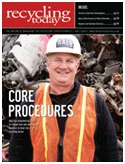BIR Announces Keynote Speaker for Spring Meeting
Delegates attending the upcoming World Recycling Convention in Istanbul will be able to hear Hamish McRae, a futurist and economic analyst, who will offer his vision of the world economy in the next 25 years. Event organizer, the Brussels-based Bureau of International Recycling (BIR), has arranged for McRae to address attendees of the event.
McRae, an associate editor and principal economic commentator for the U.K.’s The Independent, published the book The World in 2020: Power, Culture and Prosperity. His latest work, What Works: Success in Stressful Times, focuses on excellence in the world economy, the shift of economic power to Asia and how technology interacts with human capital to shift competitive advantage.
McRae’s presentation will examine what the world will look like in the next 25 years. The emergence of culture and values as competitive advantages for industrialized nations signals a profound shift in world order, he says. McRae demonstrates how changes in demography, the environment, government, technology and natural resources will contribute to this new competitive landscape.
Additional information on the World Recycling Convention can be found at www.bir.org.
PaperStock Prices Climb
Ranjit Baxi, president of the Bureau of International Recycling’s (BIR’s) Paper Division and president of J&H Sales International Ltd., London, writes in the April edition of the organization’s publication, World Mirror, “The swing in business trends following the world’s emergence from recession became very noticeable at the start of 2010. Strong demand from Asia, and especially China, was accompanied by equally strong demand within Europe.”
Baxi notes that container shipping lines, which were projected to post losses of nearly $20 billion for 2009, increased basic freight rates and also imposed surcharges, such as an emergency bunker fuel surcharge.
He notes that in the first quarter of 2010, recyclers incurred total freight increases of $400 to $500 per 40-foot container, with an additional increase of $150 to $200 in April.
“The tough winter, the worst for 30 years, contributed to greatly reduced collections of fiber at a time of increasing global demand, resulting in a strong increase in recovered paper prices in the first quarter,” Baxi writes. “Paper mills reflected these higher fiber costs in increased prices for their finished paper products.”
The weakening euro is affecting European exports. The euro has decline by more than 5 percent against the U.S. dollar since the start of the year, he notes.
Recovered fiber pricing had been trending upward. “In the first quarter, OCC showed a strong upward trend, moving up from $195-plus per metric ton in January to $235-plus prior to Chinese New Year,” Baxi writes. “Following this holiday period, mills were reluctant to procure material at pre-New Year prices, leading to downward price adjustments to $230-plus in March.” Pricing ended the month at approximately $215.
Mixed paper prices grew from roughly $175 per metric ton to more than $195 by early February, he notes. “Once again, mill buyers were seeking lower levels in March, and the price dipped to $185-plus.” Baxi says he anticipates an increase in recovered paper collection. However, he is less sure about pricing, saying, “whether prices are sustained at end-March levels will depend greatly on demand within Europe, on currency volatility and, more importantly, on how far the shipping lines feel they can push freight rates.”
BIR members can access Baxi’s full report by visiting www.bir.org.
Get curated news on YOUR industry.
Enter your email to receive our newsletters.

Explore the May 2010 Issue
Check out more from this issue and find your next story to read.
Latest from Recycling Today
- AF&PA report shows decrease in packaging paper shipments
- GreenMantra names new CEO
- Agilyx says Styrenyx technology reduces carbon footprint in styrene production
- SABIC’s Trucircle PE used for greenhouse roofing
- Hydro to add wire rod casthouse in Norway
- Hindalco to invest in copper, aluminum business in India
- Recycled steel price crosses $500 per ton threshold
- Smithers report looks at PCR plastic’s near-term prospects





